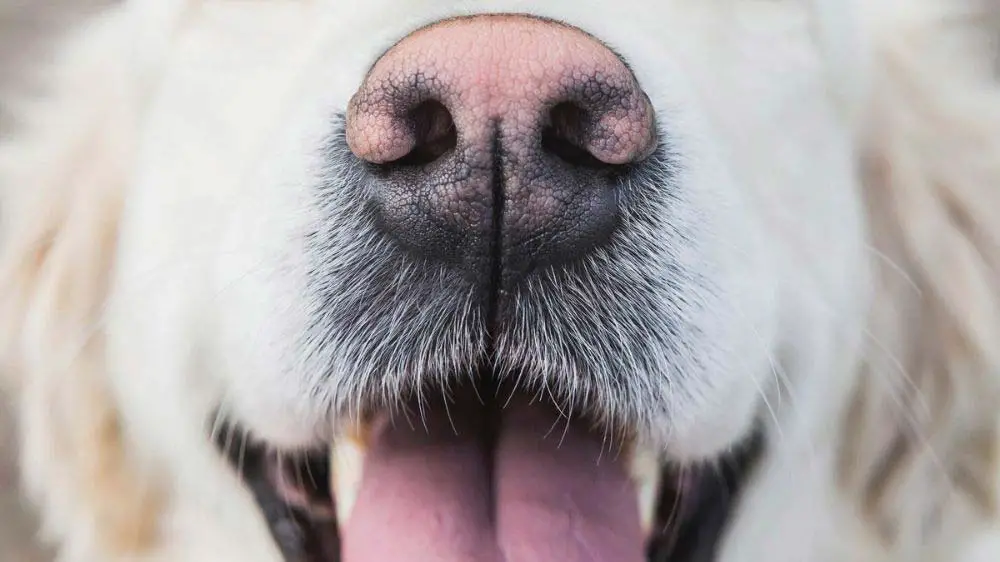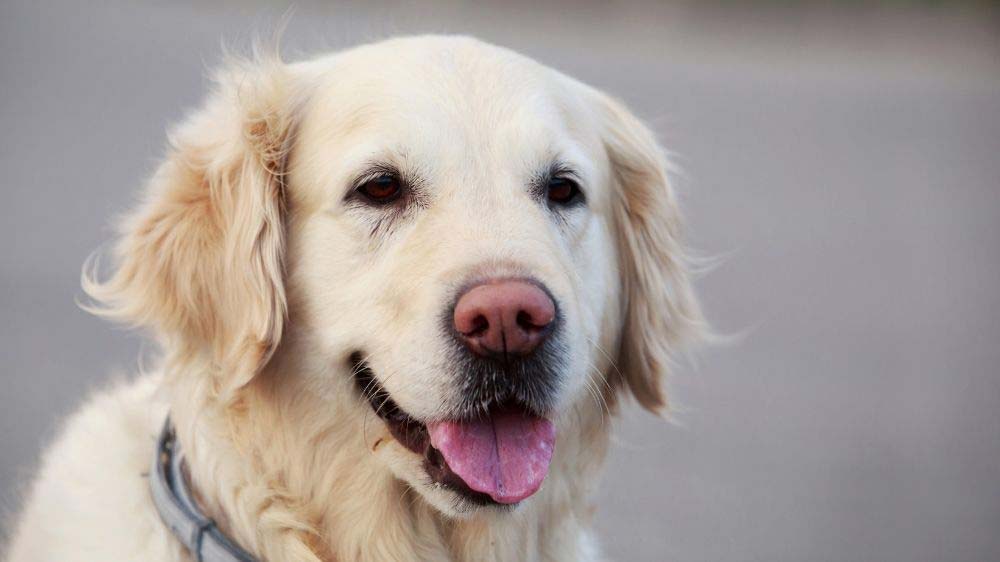There’s nothing more satisfying than booping your Golden Retriever’s snout. But as you do, you may realize that your dog’s nose has a few pink or brown patches. You might wonder: Why is my Golden Retriever’s nose turning pink (or brown)?
A Golden Retriever’s nose can turn pink or brown due to hypopigmentation, often called “snow nose”. Once thought to be a winter condition, your Golden Retriever’s nose can change color during any season. If there is no itching, scaling, crusting, or bleeding, there is no need to worry.
If you’d like to know more about your Golden Retrievers pink nose, read on. I’ll discuss everything related to that condition and also point out the signs that require veterinary attention.

(This article may contain affiliate links and loyalgoldens may earn a commission if a purchase is made.)
Unlock your goldens natural intelligence and see just how quickly problem behaviors disappear.This is the best at home dog training I've ever used!
Snow Nose in Golden Retrievers
Snow nose — also known as winter nose or seasonal hypopigmentation — is a common condition that can affect almost any dog breed. However, it’s more common among Golden Retrievers, Siberian Huskies, Labrador Retrievers, and Bernese Mountain Dogs,
The color a dog’s nose turns depends on the original color of their nose. Since Golden Retrievers have a black nose, their nose will typically turn pink, although sometimes their noses can appear to be a darker brown. While this nose color change happens in Goldens during the winter more often than not, it can happen at any time of year, and in any climate.
A few years ago, researchers believed snow nose was directly linked to cold climates, hence the name. However, we now know that it can also happen in perfectly warm climates and even in tropical areas.
Regardless of when it happens, a Golden Retrievers nose will generally return to it’s black pigment color over time, and you may expect that a Golden that has shown signs of snow nose will be likely to experience the color change again.
A Golden Retriever with a pink nose due to snow nose, is not ill, and is not suffering from a potentially harmful medical condition.
What Causes Snow Nose in Golden Retrievers?
Researchers are still unsure about how snow nose develops.
The most accepted theory is linked to an enzyme called tyrosinase. Simply put, this enzyme is responsible for producing melanin, the dark pigment that makes your dog’s nose black.
Melanin is not just a cosmetic substance, though — it protects your dog against the harmful rays of the sun.
Normally, melanin production increases in response to frequent sun exposure as some sort of a defense mechanism.
But when that possible danger fades away in the winter, your dog’s body may stop producing melanin since it’s no longer as needed during the winter months, which will strip the nose of its black pigmentation.
How To Treat a Golden Retriever With Snow Nose
If your dog isn’t showing any signs of pain and discomfort, then no treatment is required. In most cases, your dog’s nose will turn black again over time, possibly by the beginning of spring or summer when the outdoor temperatures rise.
Should Golden Retriever Parents Be Worried About Snow Nose

Snow nose is just a cosmetic issue, so it shouldn’t be worrisome at all. The condition may start as small patches (usually at the center) before spreading to the whole nose, and that’s totally normal.
However, if you start noticing changes in the nose’s texture, you should consult your vet as soon as possible. Your dog’s nose should always have a distinct cobblestone texture. If it becomes smooth, or you notice sores and red spots, there might be an underlying nasal infection.
Can You Prevent Snow Nose in Golden Retrievers?
Since researchers and veterinarians have yet to pinpoint the specific cause of snow nose, it’s technically impossible for Golden Retriever owners to prevent. Fortunately, snow nose is nothing to really worry about. There is no link to skin problems, cancer or other medical conditions, so it ends up being just a cosmetic issue.
Does Your Golden Retriever Need Sunscreen?
If your dog’s nose has turned pink or brown, then yes — you should apply sunscreen all around the nose area to make up for the missing melanin, and to protect it from the sun when spending time outside.
And in case you’re wondering, you can’t use your personal sunscreen because it likely contains zinc oxide and para-aminobenzoic acid (PABA), both of which are toxic to dogs.
Look for a brand that creates sunscreen specifically for dogs. I like Epi-Pet’s Sun Protector Spray (Amazon) because it comes as a handy spray that doesn’t leave a mess like balms. Besides, it’s FDA-approved and provides the same protection as 30-40 SPF in human sunscreens.
To apply sunscreen on your Golden Retriever’s nose, spritz some of it on your fingers, and then gently massage onto the nose, paying particular attention to the pink spots.
Note: Keep in mind that your dog could be allergic to some sunscreens. If you notice any signs of problems after applying sunscreen, wash it off and consult your veterinarian.
Serious Health Issues Causing Pink and Brown Nose in Golden Retrievers

Discover how to train your Golden Retriever by playing games: 21 games to play with your Golden that will make them smarter and better behaved!
Though less likely than winter nose, the appearance of pink patches on your dog’s nose could be a sign of serious health issues that necessitates veterinary attention. These include, but are not limited to, the following:
Nose and Sinus Inflammation
Your Golden Retriever’s nose may become inflamed due to bacterial, viral, or fungal infection. The infection may just stop at the nose, at which point the condition will be rhinitis. But if left untreated, the microbes may creep deep inside the sinuses, and turn into sinusitis.
In some cases, bacteria may gain access to sinuses through decayed teeth. That said, only a vet can determine the root cause through physical examination and blood work.
Symptoms to Look For
If you’re concerned that your Golden Retrievers pink nose is something besides snow nose, you’ll want to look for these other symptoms.
- Pink or brown nose
- Smooth nose texture, but may become crusty with time
- Sneezing
- Coughing
- Loss of appetite
- Yellow nasal discharge
- Nosebleeds
- Decreased airflow (stuffy nose)
- Reverse sneezing
If your Golden Retriever has a pink nose, plus one or more of these other symptoms you’ll want to get your pup to the vet.
Treatment
Your vet will probably prescribe medications to get rid of the microbes responsible for the infection. If tooth decay is the root cause, you’ll have to visit a veterinary dentist to address the problem.
If your dog is having trouble breathing, you may want to shop for a humidifier to help loosen up the mucus blocking the nose.
Trauma
Just like how a person may skin their knee, dogs may scrape their noses against abrasive objects. Depending on the trauma’s severity, your Golden Retriever may have anywhere from a small scratch to a large raw area. In extremely severe cases, you may also spot nosebleeds.
You’ll want to take your dog to the vet as soon as you notice a cut or a raw patch because the nose could become infected if not taken care of.
If your Golden’s nose is actively bleeding you should try to stop it by applying pressure to the wound with a clean cloth.
Allergy
Golden Retrievers are prone to allergies just like us. If your dog is allergic to pollen, mold, dust, or certain foods, exposure to these allergens will trigger inflammation, which may tint the nose pink.
One of the most common allergies among dogs is a plastic allergy. The allergic reaction may kick in when your Golden eats or drinks from a new plastic bowl. In that case, using ceramic or stainless steel bowls will fix the problem. The Bone Dry Ceramic Pet Food & Water Sets and the PEGGY11 Stainless Steel Bowl on Amazon are both great options.
Golden Retriever Allergy Symptoms To Look For
- Swelling of the face
- Pink nose
- Itchiness
- Hives
- Diarrhea
- Sneezing
- Vomiting
- Itchy, runny eyes
- Constant licking
Report to your vet immediately if your dog is having difficulty breathing. That could be a sign of anaphylaxis, a life-threatening condition.
Treatment
After confirming the diagnosis, your vet will likely prescribe some medications to alleviate your dog’s symptoms.
There’s no way to desensitize your Golden Retriever against a certain allergen. You’ll have to avoid exposing your pup to whatever caused the reaction to prevent future problems.
Less Common Health Issues Causing Pink Nose in Golden Retrievers
- Lupus: Discoid lupus erythematosus, or DLE, is a disease where the dog’s immune cells go rogue and attack healthy skin cells. The nose will turn pink, and you may also notice crusting and scabbing.
- Pemphigus: Another disease caused by rogue immunity, pemphigus develops scabs and ulcers all over the nose. In some cases, your dog may start to lose his hair, especially around the snout.
- Vitiligo: Common among Golden Retrievers, vitiligo is a harmless condition that may appear at an early age. Some dogs may have white or pink spots just on their noses, while others may have them scattered all over the body.
Summing Up
If your Golden Retriever’s nose has turned pink or brown, this probably happened as a natural response to spending less time in the sun. It’s just your dog’s dramatic way of saying, “Winter Is Coming!”
If, however, you notice other problems besides the color change (such as sneezing, coughing, loss of appetite, and difficulty breathing), you’ll want to have your dog checked as soon as you can.
